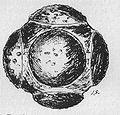Carved Stone Ball
Carved Stone Balls ( English , literally: carved stone balls ) probably originated in the late Neolithic and in the Bronze Age (3500–1500 BC). About 450 specimens are known, mostly from Aberdeenshire in Scotland .
For the most part it is assumed that the stone balls were status symbols. Hard stones such as granite , gabbro , gneiss , diabase , diorite , quartzite , and soft stones such as sandstone and serpentinite were used for the objects .
Design and manufacture
The mostly spherical, rarely oval objects are carefully and elaborately designed and vary greatly. Most are 70 mm in diameter. A little more than a dozen are between 90 and 114 mm. Most of them have six knobs, the most elaborately designed balls have four knobs and the others have a different number. The orcadian ones have most of the knobs and partly deviate completely from the spherical shape. The size of the knobs, often decorated with engraved patterns, varies. The patterns consist of linear, spiral or concentric incisions. There are also balls without decorations.
Found in Towie Aberdeenshire
Found in Kilmaurs , Scotland
Found in Golspie , Scotland, in 1933
Andrew T. Young found in an experimental study that the Scottish stone balls could be formed without the use of metals.
First investigations and locations
Frederick Rhenius Coles (1854-1929), an employee of the National Museum of Antiquities of Scotland , examined about 180 stone spheres between 1897 and 1911.
distribution
Most were found in northern Scotland in Aberdeenshire , between the Moray Firth and Tay River in the Grampian Mountains and on Orkney . Carved Stone Balls have been found in Aberdeenshire, Comrie , Dunadd , Hawick , Wigtownshire on Iona , Skye , Lewis and Harris , Uist , Arran . Outside Scotland in Ireland at Ballymena and in England at Durham , Cumbria , Lowick and Bridlington . The seven-studded diorite spheres found in Hillhead, near St. Ola, Orkney, come from Hillswick in the Shetlands . Five Carved Stone Balls were found in the Stone Age settlement of Skara Brae on the Orkney and two in Rinyo on Rousay.
Many functions for these objects have been suggested, so they could have been club heads.
Web links
- Carved stone balls by Dorothy N. Marshall (English; PDF; 2.3 MB)
- Pictures of carved stone balls on the website of the University of Aberdeen (English)
- FSA Scot: The carved stone balls of scotland: A new theory as to their use (English; PDF; 691 kB)
- Skara Brae
- Carved stone balls from Scotland (English)
Individual evidence
- ^ Information from the Ashmolean Museum , accessed May 19, 2010
- ^ University of Exter, The Ground Stone Tools of Britain and Ireland: an Experimental Approach by Andrew T. Young , accessed August 30, 2014
- ↑ Coles 1911
- ↑ Carved stone balls by Dorothy N. Marshall p. 34 (PDF; 2.3 MB), accessed on May 19, 2010
- ↑ Images of Carved Stone Balls on Skara Brae on the National Museum Scotland website, accessed May 19, 2010
- ^ Vere Gordon Childe, William A. Grant, A Stone Age settlement at the Braes of Rinyo (First Report). Proceedings of the Society of Antiquaries of Scotland 73, 1938, 27



